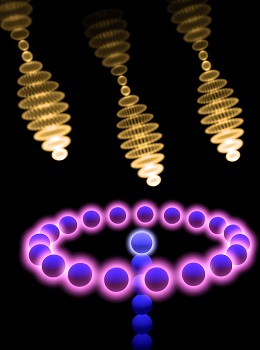Superabsorbing ring could make light work of snaps

Photo credit: (c) 2014 Simon Benjamin CC-BY
The ultimate camera pixel has been brought a step closer by a scientific study published today (Friday August 22, 2014).
Physicists from the University of St Andrews, University of Oxford and University of Queensland, Australia, have discovered a quantum effect in which excited atoms team up to absorb light, creating ‘superabsorbing’ systems that could make the ultimate camera pixel.
Superradience, a well-known phenomenon to physicists, occurs when atoms charged with energy emit light together at high speed to release a more intense pulse of radiation than they would individually. The new work shows how the effect can be reversed if the atoms couple together with each other.
The research, published in the journal Nature Communications today (Friday 22 August), could be revolutionary for devices from solar cells and digital cameras to high sensitivity light sensors.
Physicist Dr Brendon Lovett, University of St Andrews, explains:
“Quantum mechanics allows the atoms to work together, and reinforce each other, in a way that is just not possible in the classical everyday world. This has allowed us to show how atoms working in concert can absorb light much more quickly than they could if they worked on their own.”
The team of international researchers also believe they have found a solution to the problem of optimising the absorption of superradient energy, before the atoms release the energy back as light.
Kieran Higgis, University of Oxford, comments:
“We were inspired to study ring molecules, because that’s what plants use in photosynthesis to extract energy from the Sun. What we then discovered is that we should be able to go beyond nature’s achievements and create a ‘quantum superabsober’.”
At the forefront of this new design is a molecular ring, charged by 50% using a laser pulse, in order to reach the ideal superabsorbing state. To keep it in that condition, the team propose using a key property of the ring structure: each time it absorbs a photon, it becomes receptive to photons of a slightly higher energy.
Dr Lovett continues:
“We found the atoms in a molecule create a ladder of states in which the rungs are not evenly spaced. For superabsorption to happen, we need to keep the molecule near half way up the ladder. Now, each successive photon is emitted with a slightly lower energy as the molecule climbs down the ladder – so by simply stopping light below a certain energy coming out, we prevent the molecule accessing the lower rungs.”
ENDS
Notes to Editors
The study entitled ‘Superabsorption of Light via Quantum Engineering’ is published in the journal Nature Communications today (Friday 22 August 2014), and is available here – http://dx.doi.org/10.1038/ncomms5705.
The research team included Dr Brendon Lovett (University of St Andrews), PhD student Kieran Higgins (University of Oxford), Professor Gerard Milburn (University of Queensland) and Dr Erik Gauger (National University of Singapore).
Dr Brendon Lovett can be contacted for interview on [email protected] or 01334 463107.
Issued by the University of St Andrews Press Office
Contact Victoria Herd on 01334 462530 or email [email protected]
Ref: (superabsorb220814)
View the University’s latest news at http://www.st-andrews.ac.uk/news/
Category Research